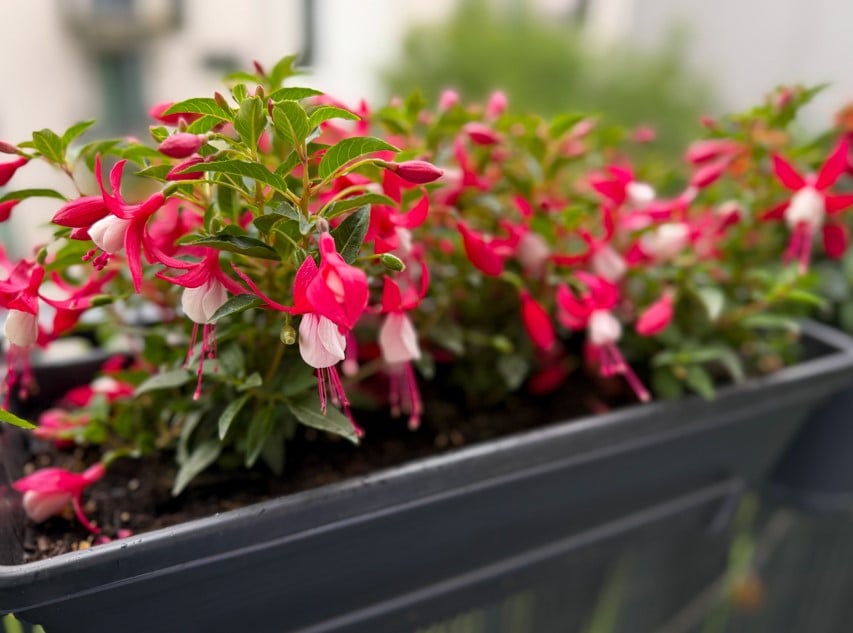Preparing Fuchsias for Overwintering: A Complete Guide for UK Gardeners

Fuchsias are among the most beloved flowering plants in UK gardens, admired for their elegant, pendulous blooms and long flowering season. Yet as the days shorten and the chill of autumn creeps in, many gardeners begin to worry about keeping their fuchsias alive through the winter months. The good news? With the right approach, you can successfully overwinter your fuchsias, ensuring they return next year as healthy and floriferous as ever.
In this blog post, we’ll explore everything you need to know about preparing fuchsias for overwintering: the different types of fuchsias and what that means for winter care, when and how to begin, step-by-step instructions for different overwintering methods, and practical tips to give your plants the best possible start next spring.
Know Your Fuchsias: Hardy vs. Half-Hardy
Before you start, it’s essential to understand what kind of fuchsias you’re growing. Broadly speaking, fuchsias fall into two categories:
Hardy Fuchsias
These varieties, such as Fuchsia magellanica and Fuchsia riccartonii, are more robust and can survive UK winters outdoors, especially in milder regions or sheltered spots. Even so, they benefit from a bit of protection during prolonged cold spells.
Half-Hardy (or Tender) Fuchsias
These include many of the popular basket and patio varieties. They won’t survive freezing temperatures and must be brought indoors or kept frost-free over winter.
Identifying your plant’s type will help you decide on the most suitable overwintering method.

When to Start Preparing Fuchsias for Winter
Timing is crucial. In the UK, preparations generally begin in late September to October, when nights become noticeably cooler and before the first frost. Acting early gives your plants time to adapt and ensures you’re not caught out by an unexpected cold snap.
Step 1: General Preparation
Regardless of type, start by giving your fuchsias some seasonal TLC:
- Prune back flowered stems to tidy the plant and reduce stress.
- Remove dead or diseased material to prevent pests and fungal problems from overwintering too.
- Stop feeding around early September. Continued feeding encourages soft new growth, which is more susceptible to frost damage.
- Reduce watering as the weather cools, but don’t let the plants dry out completely.
Step 2: Overwintering Hardy Fuchsias Outdoors
If you’re growing hardy fuchsias in the ground, follow these steps: Cut Back and Mulch
- Wait until the first frosts blacken the top growth; this signals the plant is entering dormancy.
- Cut back stems to about 10–15 cm (4–6 inches) above ground level.
- Apply a generous mulch (7–10 cm / 3–4 inches deep) of compost, leaf mould, or bark chips around the base. This insulates the crown and protects roots from freezing.
Choose the Right Location
- Hardy fuchsias do best in sheltered spots, ideally against a south or west-facing wall.
- Avoid areas prone to waterlogging, as wet roots combined with frost can kill even the toughest plants.
Protect in Severe Weather
In particularly cold winters, consider covering plants with fleece or cloches during prolonged frosts.
Step 3: Overwintering Tender Fuchsias Indoors
For half-hardy or tender fuchsias, outdoor survival isn’t an option. You’ll need to bring them under cover before the first frost.
Bringing Plants Inside
- Check each plant for pests like whitefly or aphids. Treat infestations before moving indoors.
- Remove most of the foliage and cut back stems by around half to two-thirds. This helps reduce water loss and makes storage easier.
Choosing a Storage Location
Fuchsias overwinter best in a cool, frost-free place, such as:
- An unheated greenhouse
- A conservatory kept above freezing
- A garage or shed with a small window
- A cellar or loft (only if there’s some light and it stays above 0°C)
Ideal temperature: around 3–8°C (37–46°F). Too warm and the plants may start growing prematurely; too cold and they risk frost damage.
Step 4: Deciding on Dormant vs. Semi-Active Storage
Dormant Storage (Traditional Method)
- After pruning, let the plants enter full dormancy.
- Store them in a cool, dark place.
- Water sparingly—just enough to stop the compost from drying out completely, roughly every 4–6 weeks.
Semi-Active Storage
- Keep the plants somewhere cool and light (e.g., a bright porch or greenhouse kept frost-free).
- The plants won’t go fully dormant and may keep some foliage.
- Water a little more frequently, ensuring compost stays just moist.
Semi-active storage is ideal if you prefer your plants to get an earlier start in spring.
Step 5: Overwintering Fuchsias in Pots
If you grow hardy fuchsias in pots, their roots are more vulnerable to frost than those in the ground. Here’s what to do:
- Move pots into a sheltered, frost-free spot (e.g., next to the house, under eaves).
- Wrap pots with bubble wrap or horticultural fleece to insulate roots.
- Raise pots off the ground with pot feet or bricks to prevent waterlogging.
For tender fuchsias, follow the same steps as above and bring them indoors.

Step 6: Late Winter & Spring: Waking Up Your Fuchsias
From late February to March, start checking on your plants:
- Increase watering gradually as days lengthen.
- Move dormant plants into brighter, slightly warmer conditions (around 10–12°C / 50–54°F).
- Remove any dead stems or damaged growth.
When new shoots appear, you can:
- Repot if needed, refreshing the compost.
- Start feeding with a balanced liquid fertiliser every few weeks.
- Begin pinching out tips to encourage bushier growth.
Once all risk of frost has passed (usually late May in much of the UK), harden plants off by gradually acclimatising them to outdoor conditions over 7–10 days.
Troubleshooting Common Problems
Rot
Overwatering in winter is the most common killer. Always let compost become nearly dry before watering again.
Pests
Occasionally, overwintered fuchsias suffer from whitefly or red spider mite. Inspect regularly and treat promptly.
Early Growth
If your plants break dormancy too soon, give them as much light as possible and keep temperatures cool to avoid leggy growth.
Final Tips for Success
- Label your plants by variety before overwintering—easy to forget after months of storage!
- Always clean pots, tools and staging to reduce disease risk.
- Check plants regularly over winter rather than forgetting about them until spring.
In Summary
Overwintering fuchsias in the UK isn’t difficult once you understand what your plants need: hardy types benefit from pruning and mulching outdoors, while tender varieties must be protected from frost indoors. By preparing in autumn, storing correctly through winter, and giving your fuchsias care as they wake in spring, you’ll enjoy another season of glorious blooms.
With a little planning, your fuchsias can become long-lived stars of your garden year after year.
